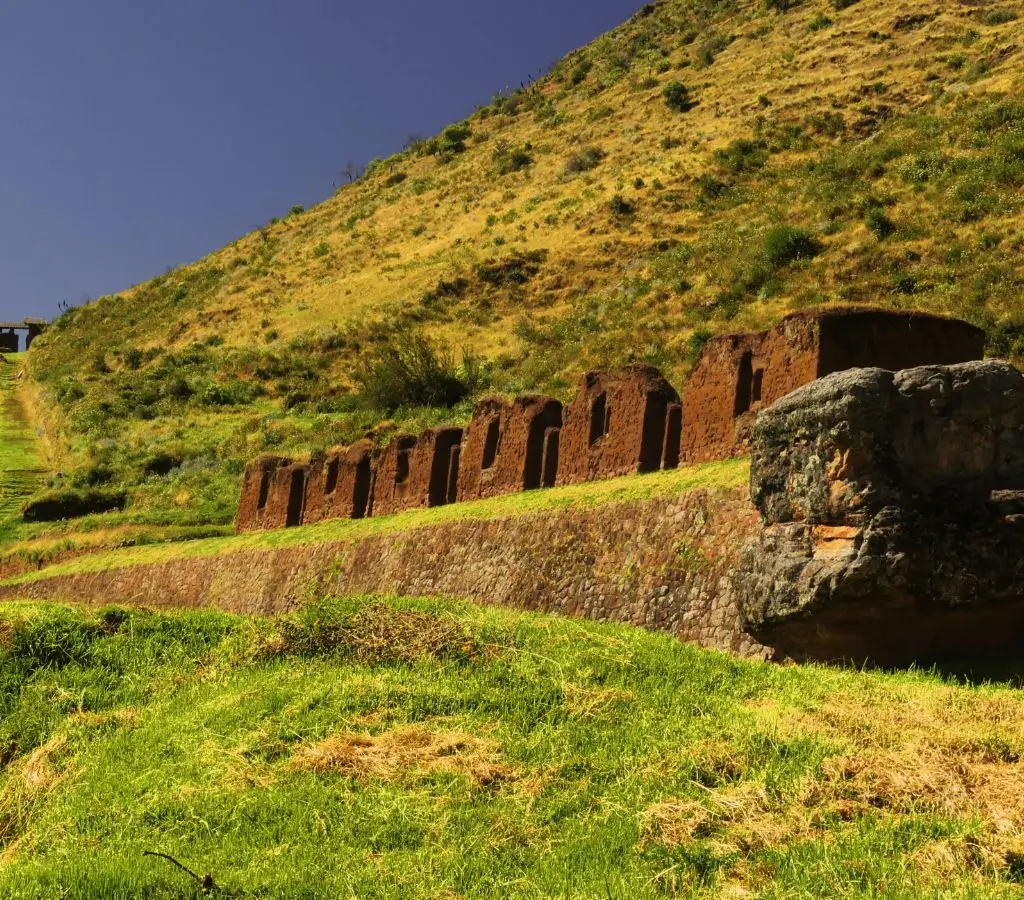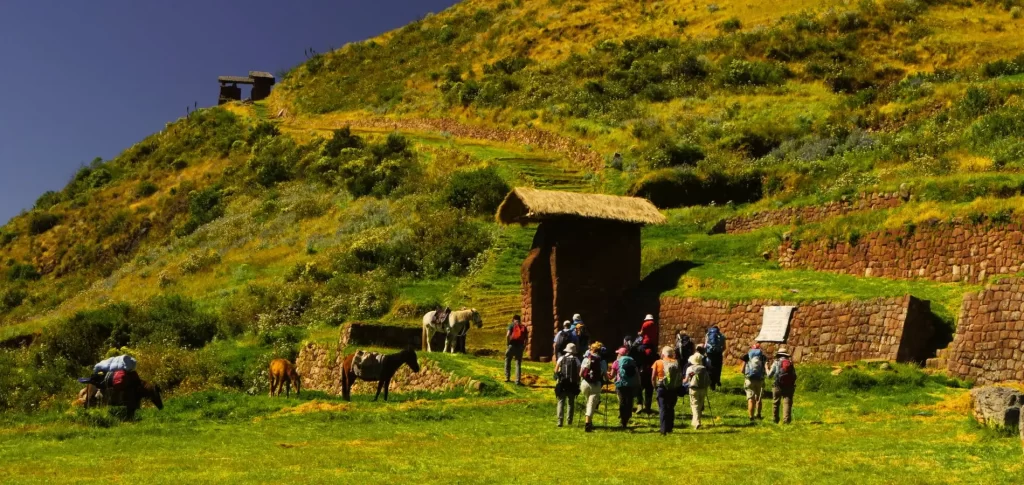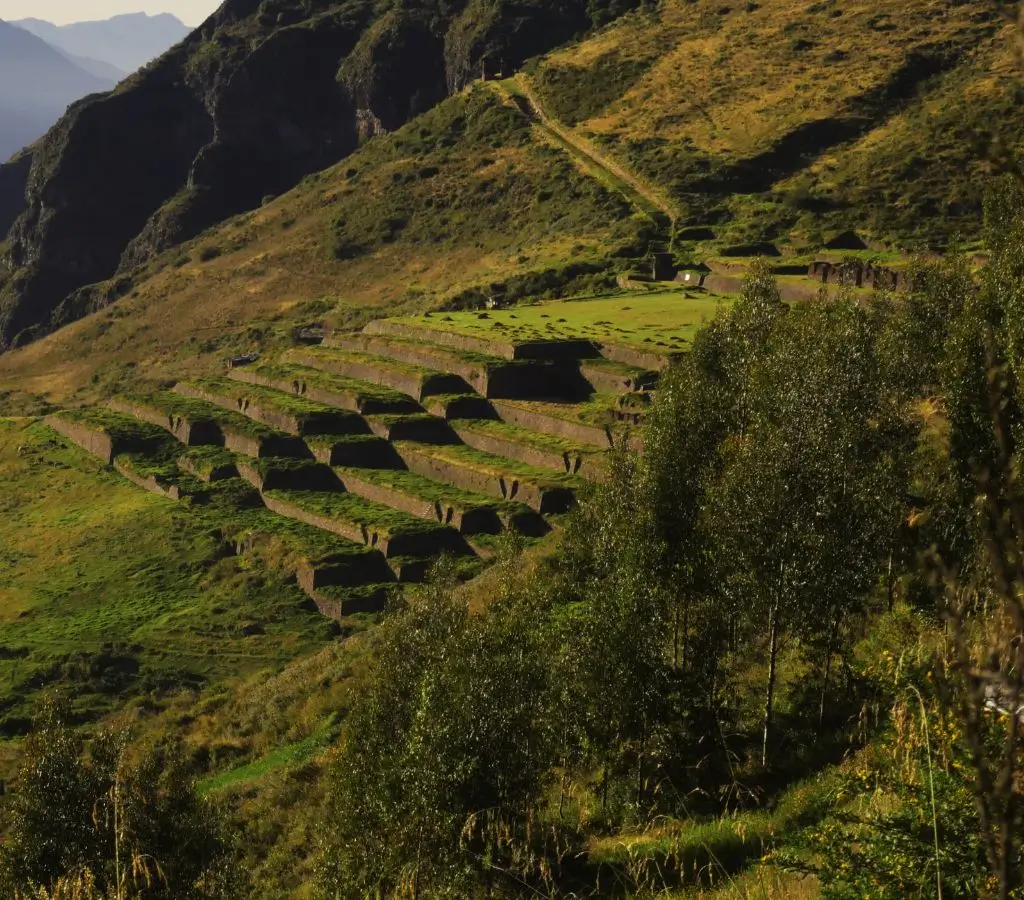Huchuy Qosqo, known as the "Little Cusco," is an archaeological site located in the Sacred Valley, near the town of Calca, in the Cusco region. It was built in the 15th century by Inca Wiracocha as a palace for him and his family. This site is characterized by its majestic adobe and stone structures, such as temples, plazas, and agricultural terraces. In addition to its impressive architecture, Huchuy Qosqo offers panoramic views of the Sacred Valley, making it an ideal destination for history, culture, and nature lovers.
Declared a Cultural Heritage of the Nation in 2003, Huchuy Qosqo is a witness to historical events, such as the resistance against the Chancas and the final days of Inca Wiracocha. Today, this archaeological site is a tourist attraction that combines history, architecture, and natural landscapes.
Huchuy Qosqo, located approximately 3,650 meters above sea level in the Sacred Valley of the Incas, is cold and dry, with temperatures ranging between 10 °C and 20 °C during the day and dropping significantly at night.
It is recommended to wear appropriate clothing for the cold and high mountains, including layers for the day and warm clothing for the night. Additionally, it is important to be prepared for sudden weather changes, especially during the rainy season.
The archaeological site of Huchuy Qosqo or Little Cusco is located to the north of Cusco, at an altitude of over 3670 m; precisely above the community that bears the same name, just a few meters from the city of Calca, in the Cusco department.
The archaeological site of Huchuy Qosqo was built on the high part of a mountain in the late 15th century. The Incas connected this path to the Sacred Valley of the Incas to expand their territories. The construction of this archaeological complex was ordered by the Inca Wiracocha, who decided it would be one of his palaces for himself and his family.
According to historians, the original name of this center was Qacya Qawarina, which means "where the thunder is," but over time, the Cusco native Jose Gabriel Cosio renamed it Huchuy Qosqo, and that name prevailed.
It is built of adobe and stone. After the invasion by the Chancas, Wiracocha and his son Inca Urco escaped to Huchuy Qosqo, leaving the position to their son Tupac Inca Yupanqui or Pachacútec to fight in the resistance, as noted by the chronicler Pedro Cieza de León.
On the other hand, the Spanish chronicler Juan de Betanzos mentions that Inca Wiracocha spent his last days in Huchuy Qosqo, also known as Qaquia Jaquijahuana, the emperor's preferred location where he lived until the age of eighty.
Years later, the Spanish conqueror Gonzalo Pizarro found a mummy, possibly belonging to Inca Wiracocha, and ordered it to be burned. However, the Inca's descendants decided to preserve the ashes in a jar for many years. It was later discovered by the chronicler Polo de Ondegardo.
Huchuy Qosqo comes from Quechua and translates to "Little Cusco." However, the archaeological site originally had names like Qacya Qawarina, Qaqyaqawana, or Qaqyaxaqixawana, which mean "where the thunder is." Perhaps we wonder what these names mean. This is because Huchuy Qosqo is located at an altitude of 3600 meters, allowing the observation of the lights and sounds of this meteorological phenomenon.
Huchuy Qosqo surprises us with many things, such as its architecture with a fine finish. The stones are well polished, allowing you to admire the three-level buildings that are still preserved despite being over 500 years old. The panoramic view is impressive, and finally, it dazzles us with its agricultural terraces and platforms, giving a special effect to the place.
Huchuy Qosqo is a fascinating Inca archaeological site located in the heights of the Sacred Valley in Peru. This "Little Cusco" stands out for its impressive stone and mud ruins, agricultural terraces, and a privileged location with panoramic views of the valley and the Andean mountains.
Exploring Huchuy Qosqo is an enriching experience that combines history, culture, and nature. Here is a unique guide to discover the treasures of this site:
1. Main Ruins of Huchuy Qosqo: You cannot miss the central structures of the site, including ancient residences, squares, and temples. These buildings, constructed with a blend of Inca and pre-Inca techniques, offer a window into the past and the architectural sophistication of the Incas.
2. Llama Trekking in Huchuy Qosqo: At Illapa Culturas Andinas, we offer an incredible tour in the Andes that combines nature, tradition, and sustainable tourism. Accompanied by our llamas, we embark on an adventure in the Cusco Andes. This Llama Trekking in Huchuy Qosqo is a unique experience that you shouldn't miss when visiting Cusco.
3. Agricultural Terraces: The terraces are an engineering marvel of the Inca civilization, used for agriculture, maximizing the use of mountainous terrain. Walking among them provides a unique perspective on how the Incas interacted with their environment.
4. Huchuy Qosqo Viewpoint: From here, you'll get breathtaking views of the Sacred Valley and the Andes mountains. It's a perfect spot for photography and contemplating the vastness of the Peruvian landscape.
5. Journey through the Inca Trail to Huchuy Qosqo: For adventurers, there is a trekking route that connects Cusco with Huchuy Qosqo. This hike takes you through stunning Andean landscapes and is an excellent way to experience the nature and history of the region.
6. Huchuy Qosqo Interpretive Center: This center provides valuable information about the history and significance of the site, serving as a good starting point to better understand what you will see in the ruins.
7. Camping Area: For the more adventurous, spending a night at the campsite near the ruins can be a magical experience, and waking up with a view of the Sacred Valley is simply unforgettable.
8. Local Flora and Fauna: While exploring, keep your eyes open to see the diverse Andean wildlife, including llamas and alpacas, as well as the unique flora of the region.



You can visit from early morning until around 4 in the afternoon, but this will depend on the return hike you undertake; as remember you have to return to the city, and this will take you approximately 3 hours at most for your return.
The cost of entry is 10 soles for both national and foreign tourists.


